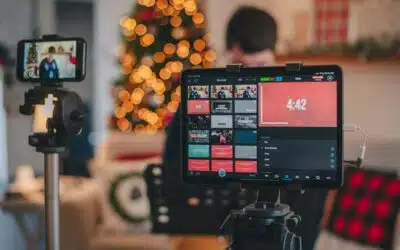Live streaming has become an increasingly popular way for businesses to connect with their audience and promote their brand. With platforms like Facebook Live, Instagram Live, Twitch, YouTube Live, TikTok LIVE, and LinkedIn Live, there are a variety of ways to engage with your audience in real-time. In this article, we’ll discuss the best practices for live streaming for your business, including where to go live, why live streaming is important for small businesses, and how to effectively promote and engage with your audience.
What is Live Streaming?
Live streaming is the process of broadcasting real-time video footage over the internet to a large audience. Live streaming allows businesses to connect with their audience in real-time, creating an interactive experience where viewers can ask questions and engage with the content being presented. Live streaming can be used for a variety of purposes, including product launches, Q&A sessions, webinars, and virtual events.
Where is the Best Place to Go Live?
There are several popular platforms for live streaming, each with its own unique features and benefits. Here are some of the most popular platforms for live streaming:
- Facebook Live: Facebook Live is one of the most popular platforms for live streaming, with over 2 billion monthly active users. With Facebook Live, businesses can stream to their followers in real-time and interact with them through comments and reactions.
- Instagram Live: Instagram Live is a popular platform for businesses looking to connect with their audience on a more personal level. With Instagram Live, businesses can stream live video to their followers and engage with them through comments and reactions.
- Twitch: Twitch is a popular platform for businesses in the gaming and esports industries. With Twitch, businesses can stream live gameplay, host Q&A sessions, and interact with their audience through chat.
- YouTube Live: YouTube Live is a popular platform for businesses looking to reach a large audience. With YouTube Live, businesses can stream live video to their subscribers and engage with them through comments and reactions.
- TikTok LIVE: TikTok LIVE is a popular platform for businesses looking to reach a younger audience. With TikTok LIVE, businesses can stream live video to their followers and interact with them through comments and reactions.
- LinkedIn Live: LinkedIn Live is a professional platform for businesses looking to connect with their audience in a more business-oriented setting. With LinkedIn Live, businesses can stream live video to their followers and interact with them through comments and reactions.
Why Should a Small Business Consider Live Streaming?
There are several reasons why small businesses should consider live streaming:
- Increased Engagement: Live streaming allows businesses to connect with their audience in real-time, creating an interactive experience where viewers can ask questions and engage with the content being presented.
- Cost-Effective: Live streaming is a cost-effective way for businesses to reach a large audience without the need for expensive equipment or production costs.
- Builds Trust: Live streaming allows businesses to connect with their audience on a more personal level, which can help build trust and establish brand loyalty.
- Improves SEO: Live streaming can improve a business’s search engine optimization (SEO) by providing fresh content that is relevant to their audience.
Best Practices for Live Streaming
Here are some best practices for live streaming that businesses should follow to ensure a successful broadcast:
- Choose the Right Tool: Choose the platform that is best suited for your business and the audience you want to reach. Each platform has its own unique features and benefits, so choose the one that aligns with your business goals and objectives.
- Promote Your Live Stream in Advance: Promote your live stream in advance to generate buzz and increase the number of viewers. Use social media, email marketing, and other channels to promote your live stream and encourage viewers to tune in.
- Create a Plan for Engagement: Plan ahead for how you
will engage with your audience during the live stream. Consider ways to encourage interaction, such as asking for questions and feedback, and responding to comments in real-time. This will help create a more engaging experience for your audience and build a stronger connection with them.
- Include a Call to Action: Including a call to action (CTA) at the end of your live stream can help drive engagement and conversions. Encourage viewers to take action, such as visiting your website, signing up for a newsletter, or purchasing a product or service.
- Extend the Life of Your Live Stream: Once your live stream is over, don’t let it go to waste. Repurpose the content by creating highlights, clips, and blog posts that can be shared on social media and other channels. This will help extend the life of your live stream and reach a wider audience.
Examples of Effective Live Streaming for Business
Here are some examples of businesses that have effectively used live streaming to engage with their audience:
- Glossier: Beauty brand Glossier used Instagram Live to launch a new product line, allowing viewers to ask questions and get a first look at the new products.
- Sephora: Beauty retailer Sephora used Facebook Live to host a virtual makeup tutorial, showcasing new products and providing tips and tricks to viewers.
- Red Bull: Energy drink brand Red Bull used Twitch to host a gaming tournament, featuring popular streamers and engaging with their audience through chat.
- NASA: NASA used YouTube Live to broadcast the landing of the Mars rover, providing real-time updates and engaging with viewers through comments and questions.
Conclusion
Live streaming can be a powerful tool for businesses looking to connect with their audience and promote their brand. By choosing the right platform, promoting your live stream in advance, creating a plan for engagement, including a call to action, and extending the life of your live stream, you can create an engaging and effective broadcast. By following these best practices and examples, you can use live streaming to reach a wider audience, build brand loyalty, and drive conversions for your business.



